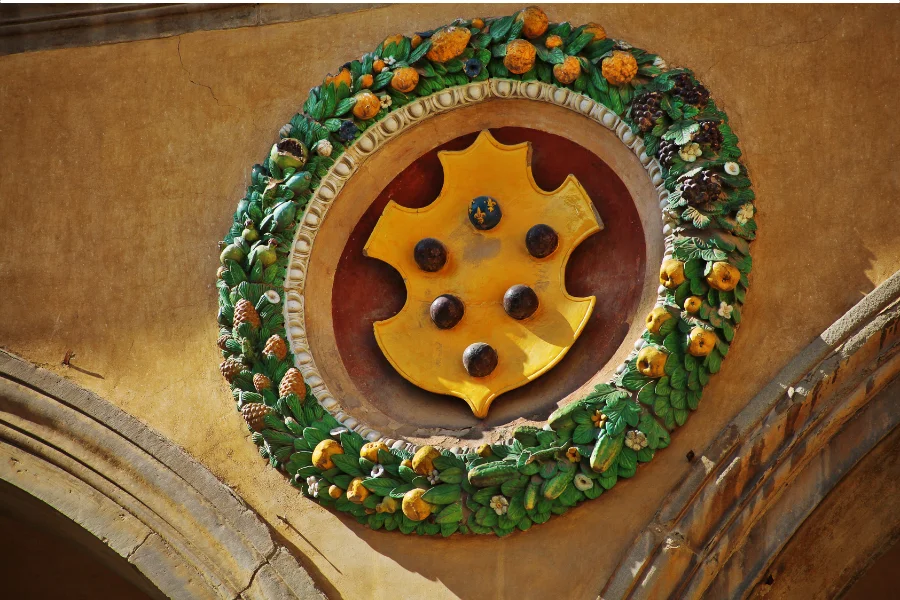
The Medici Family is one of the most influential dynasties in European history. Emerging from humble beginnings in Florence, they shaped the Renaissance’s political, cultural, and financial landscapes.
Their extensive patronage of the arts and influential role in developing Renaissance culture are at the heart of their legacy.
When exploring the Medici dynasty, it is impossible to overlook their significant contributions to politics and religion.
Their influence spanned several centuries, producing notable figures such as Cosimo, Lorenzo, and Catherine, who left their marks on Italy and beyond.
By controlling banking and politics in Florence, the Medici became pivotal supporters of Renaissance artists like Michelangelo and Leonardo da Vinci.
The Medici’s impact extended beyond Italy, influencing European culture and politics and further solidifying their power and legacy. Their ability to navigate the challenges of their time ensured their status as protectors of the arts.
For those interested in how the Medici family balanced power with patronage, the family’s legacy offers a captivating story of ambition and innovation.
Origins and Rise to Power
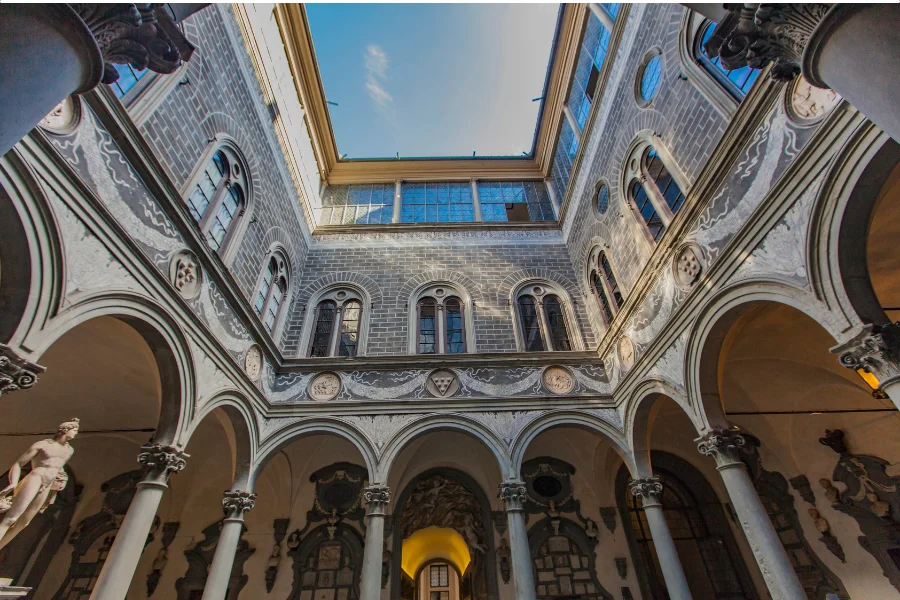
The Medici family, synonymous with Renaissance Florence, began as ambitious merchants and bankers.
Establishing themselves in the financial world enabled them to influence politics and culture profoundly. Their rise illustrates the intertwining of economic prowess and political influence.
Early History and Banking Success
The Medici family’s origins can be traced back to the 12th century in the Tuscan countryside. By the late Middle Ages, they had migrated to Florence, where they laid the foundations for their future influence.
Their rise began with Giovanni di Bicci de’ Medici, who created the Medici Bank in the early 15th century.
The bank’s success was unprecedented, making it one of the most respected financial institutions in Europe.
Giovanni focused on innovative banking practices, such as establishing European branch offices. This enabled efficient currency exchange and financial transactions, which were crucial in consolidating their wealth and power.
The Medici secured even more significant influence by becoming the papacy’s banker. This financial strength set the stage for their political ascendancy in Florence, reflecting the ambitions of Florence, Italy’s Medici family.
Political Ascendancy in Florence
The Medici family’s political power grew in tandem with their financial success. In 1434, Cosimo de’ Medici became the de facto ruler of Florence.
His strategic alliances and wealth allowed him to overshadow other noble families, such as the Albizzi, consolidating his position.
Cosimo supported a government favorable to his interests, ensuring political and economic decisions aligned with the Medici’s goals.
The family’s influence pervaded every aspect of civic life through patronage of the arts and strategic marriages.
This powerful alliance between wealth and governance laid the groundwork for the Medici dynasty’s enduring legacy in Florence, Italy.
Influence of the Medici on the Renaissance
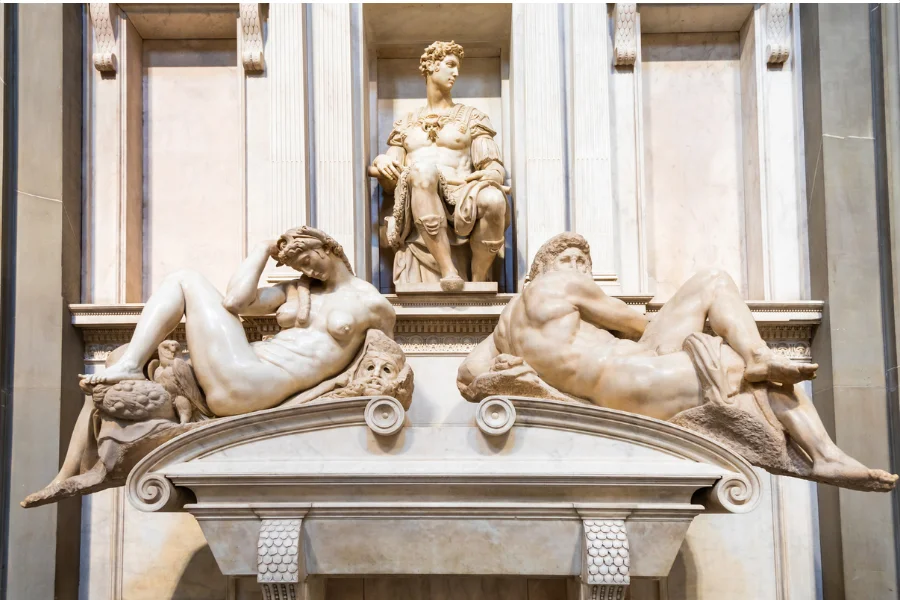
The Medici were far more than a wealthy banking family; their influence extended well into the arts and sciences, making them the beating heart of the Renaissance. They were masters in the truest sense, not only as savvy financial brokers but as cultivated patrons of culture and knowledge.
Medici’s Patronage and the Flourishing of Art and Science
The Medici recognized the power of art and intellectual pursuits, making significant contributions that transformed Florence into the artistic and cultural hub of the era. Their extensive collection of Medici paintings symbolized their love for the arts and their immense wealth.
The Medici and Leonardo Da Vinci
One of the most profound relationships the Medici fostered was with the polymath Leonardo Da Vinci. The family’s patronage played a significant role in Leonardo’s life and career, enabling him to pursue a range of interests. Our in-depth look at Leonardo’s life on our Leonardo Da Vinci biography page reveals more about this relationship.
Furthermore, Leonardo’s innovative spirit, deeply supported by Medici patronage, also extended to remarkable engineering feats, such as his visionary bridge design, which is explored on our da Vinci bridge.
Additionally, Leonardo’s inventive genius, supported by the Medici, led him to design advanced war machines, including his famous armored tank, described on our da Vinci tank.
Patronage of Prominent Artists
The Medici’s support wasn’t limited to Leonardo da Vinci. They were patrons to a dazzling array of artists who have left an indelible mark on the world.
This includes Michelangelo, whose David can still be seen standing tall in Florence, and Sandro Botticelli, whose iconic works like ‘The Birth of Venus’ were made possible through Medici patronage. Raphael, another artist funded by the Medici family, created masterpieces that still captivate audiences today.
The Medici’s influence on these artists and their creations shaped art history, genuinely making them the Medici masters of Florence.
Medici family timeline
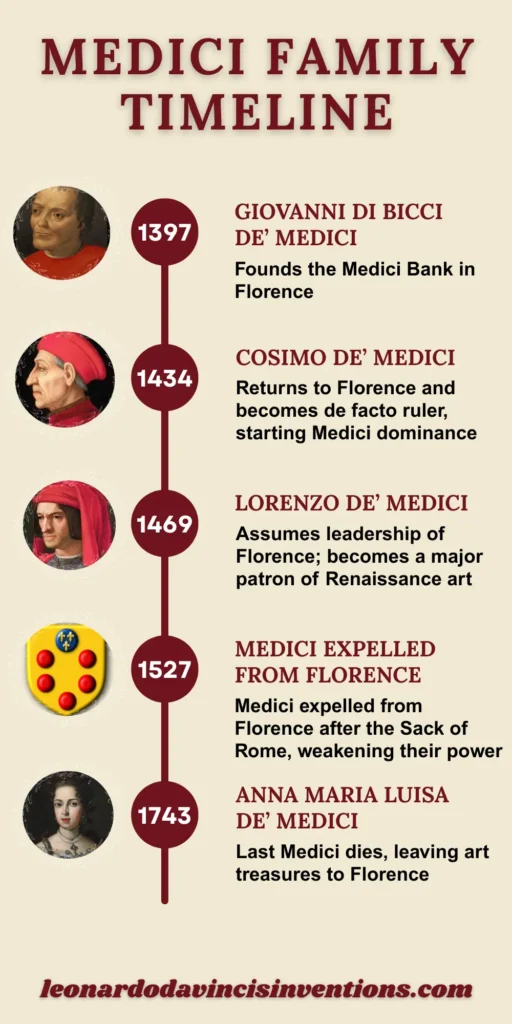
This Medici family timeline highlights the rise and fall of Florence’s most powerful dynasty, from the founding of the Medici Bank in 1397 to the end of the family line in 1743.
Key figures such as Cosimo, Lorenzo the Magnificent, and Anna Maria Luisa exemplify how their legacy profoundly influenced Renaissance art and politics.
The Contribution of Cosimo de Medici
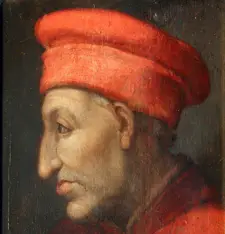
Cosimo de’ Medici, also known as Cosimo the Elder, founded the Medici dynasty in the 15th century. Born in Florence, Italy, Cosimo rose to power through banking, amassing significant wealth and influence.
His patronage of the arts and architecture laid the groundwork for the Renaissance. Cosimo supported artists like Donatello and Brunelleschi, funding their projects.
His political acumen helped maintain peace in the region, contributing to Florence’s stability.
Cosimo’s role in organizing the Medici family finances enabled his descendants to maintain power. He carefully balanced power dynamics, ensuring that Florence remained under Medici control without appearing overtly dictatorial.
The Impact of Lorenzo de Medici, The Magnificent
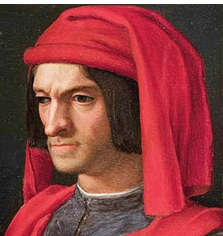
Lorenzo de’ Medici, often referred to as the Magnificent, belonged to the third generation of Medici rulers.
Known for his diplomatic skills, he played a vital role in maintaining peace among the Italian states.
Lorenzo was a central figure during the Italian Renaissance, supporting artists like Michelangelo and Leonardo da Vinci.
His leadership continued the Medici family’s influence over Florence, balancing political power with cultural contributions.
Lorenzo’s commitment to art and humanism left a lasting cultural legacy.
Despite facing political challenges, including assassination attempts, he maintained his family’s power. His reign marked a high point for the Medici dynasty, solidifying their status as patrons of the Renaissance.
Catherine de Medici
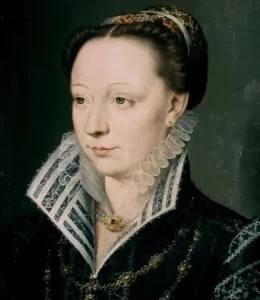
Catherine de Medici became Queen of France through her marriage to Henry II.
Her upbringing in the Medici family gave her the skills to navigate complex political landscapes.
Influential in French politics, Catherine was known for her role in the Wars of Religion, where she aimed to stabilize religious tensions.
Her time as queen saw the flourishing of arts and culture, echoing the values of her Medici upbringing.
Catherine’s influence extended to her children’s reigns, helping to shape French history.
Her complex legacy encompasses her efforts to balance power amidst religious conflict and her promotion of the arts, a legacy similar to that of her Medici ancestors.
The Medici Popes
Continuing to thread their influence through the rich tapestry of history, the Medici family extended their reach even to the hallowed halls of the Vatican.
The Papacy, the spiritual and political hub of the Catholic world, had two Popes who belonged to the illustrious Medici family.
Pope Leo X (Giovanni de’ Medici)
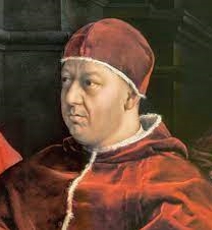
The first Medici Pope, Leo X, was born Giovanni de’ Medici. His ascent to the papal throne in 1513 marked the immense power the Medici wielded in Florence and the broader Italian political landscape.
Known for his love of the arts, Leo X’s reign continued the family tradition of patronage, supporting artists such as Raphael and Michelangelo. This era, marked by a profound flourishing of art and culture, became known as the High Renaissance.
Pope Clement VII (Giulio de’ Medici)
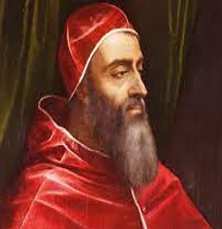
The second Medici Pope, Clement VII, was born Giulio de’ Medici. He ascended to the papacy in 1523, a decade after Leo X.
His reign was fraught with political turmoil and conflict, notably the Sack of Rome in 1527. However, despite these challenges, he remained a dedicated patron of the arts and continued to uphold the family’s commitment to cultural advancement.
Through these two figures, the Medici cemented their influence within the highest echelons of religious and political power, affirming their status as one of the most significant families in history. The Medici Popes are yet another chapter in the Medici history, underlining their broad and lasting impact on various spheres of society.
Downfall and Legacy
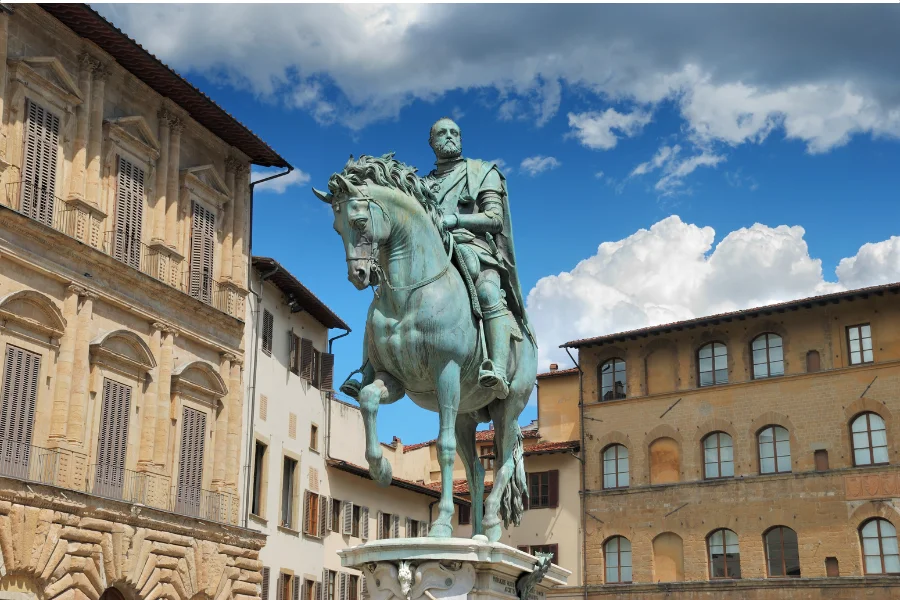
The Medici family’s influence stretched across politics, art, and science during the Renaissance. However, their fall from power and enduring influence profoundly shaped Europe.
The End of Medici Power
The Medici family’s decline began in the late 16th century. Internal rifts and poor succession planning weakened their control.
After ruling Florence for generations, the last male heir, Gian Gastone de’ Medici, died without an heir in 1737. With him, the main branch of the Medici dynasty faded.
The family’s dominance in Florence and Europe came to an end, but their cultural impact remained significant.
The Medici as Patrons of Science
The Medici were patrons of the arts and fostered scientific discovery.
Under their support, figures like Galileo Galilei thrived.
Their investment in scientific research helped ignite the European scientific revolution.
The Medici family’s support for innovation ensured that their contribution to science would echo for centuries.
This patronage demonstrated a commitment to advancing knowledge during the Renaissance period.
Medici Influence Beyond Florence
The Medici family’s legacy reached far beyond Florence.
Their political strategies and patronage practices influenced governance and culture throughout Europe.
By marrying into royal families, they solidified their influence across the continent.
Catherine de’ Medici, for example, became Queen of France, spreading Medici cultural practices.
Their legacy as patrons of the arts and sciences influenced Italy and helped shape European Renaissance culture.
The Medici family’s influence is still evident in art, architecture, and science, underscoring their enduring historical legacy.
The Medici Family in the 21st Century
You’re not alone if you’re curious about the Medici family today. Many wonder if there are any descendants of the influential family still around.
To answer that, let’s delve into the winding narrative of the Medici lineage.
Are There Any Medicines Left Today?
The last Medici whose lineage could be traced directly to the original was Anna Maria Luisa de Medici, who passed away in 1743.
After her, the direct lineage of the Medici family officially ended. However, descendants of the Medici do exist today, but they come from indirect lineage.
These are descendants of families that intermarried with the Medici over the centuries. They might not carry the Medici name, but they carry Medici blood nonetheless.
The Current Medici Heir
Due to the indirect nature of the descendants, determining a single Medici heir today is a challenging task.
But it’s interesting to note that some individuals claim to be descendants of the Medici and have even used the famous family name.
One such person is Prince Ottaviano de’ Medici di Toscana, who, in 2021, represented a group claiming to be the rightful heirs of the Medici family. However, historians debate the accuracy of such claims.
Wealth of the Medici Family
To fully appreciate the magnitude of the Medici family’s wealth, it’s worth placing it in context alongside the fortunes of other illustrious Italian families throughout history.
Comparing the Medici Fortune
The Medici were synonymous with opulence in their prime, having amassed a staggering wealth through their banking empire. Indeed, the Medici name is often the first to come to mind when discussing the wealthiest families in Italian history.
However, they weren’t the only ones sitting on a goldmine. Italy has been home to many wealthy and influential families.
For instance, the Borgia, Sforza, and Visconti families were renowned for their wealth and power at various points in history.
Even so, the Medici family’s uniqueness lay in the scale of their wealth and how they utilized it. The Medicis were savvy investors in culture and knowledge, and their patronage of the arts left behind an arguably unmatched cultural and artistic legacy.
Their wealth was also instrumental in politics. The Medici produced four Popes and two Queens of France, influencing the course of Italian history and the broader European stage.
Final Thoughts
The Medici family’s legacy is as rich and intricate as a Renaissance tapestry, fittingly so, considering their pivotal role in propelling this golden age of human history.
With their pioneering influence in banking and finance, as well as their unparalleled patronage of the arts and sciences, they indelibly shaped Europe’s cultural and political landscape.
From Cosimo de’ Medici, who laid the foundations of the family’s wealth, to Lorenzo de’ Medici, fondly known as Lorenzo the Magnificent, who steered Florence into an era of peace and artistic flourishing, the dynasty has left a lasting imprint.
Beyond Florence’s borders, they cemented their influence through the Medici popes, extending their sphere to the highest echelons of religious power.
Their support and patronage gave rise to timeless masterpieces by da Vinci, Michelangelo, and Botticelli, all of which are cornerstones of the Renaissance.
Frequently Asked Questions
The Medici family was a powerful and influential dynasty in Italy, renowned for its significant impact on art and politics during the Renaissance. Their story includes intriguing details about their rise to power, wealth, and decline.
The Medici family line continues today, although not in any official or ruling capacity. Many descendants live in various parts of Europe.
The Medici are best known for their role as patrons of the arts and their significant influence on the Renaissance.
The vast wealth of the Medici family was passed down through generations. However, it eventually dwindled over the centuries.
The Medici family fell due to political struggles, financial losses, and the lack of male heirs in later generations.
They lost their wealth through continuous spending on wars. They also lost it through lavish lifestyles and investments that did not yield returns.
The Medici would be considered multi-billionaires if their historical wealth were adjusted for inflation.
They were often disliked due to their concentration of power and influence. This led to political jealousy and rivalries.
It is speculated that Grand Duke Francesco I de’ Medici might have died from complications related to syphilis.
The Medici family is no longer in power. They lost their political influence centuries ago.
During the Renaissance, the Medici family was considered the most powerful in Italy due to their significant influence in banking and politics.
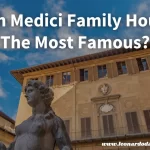
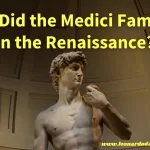

 Leonardo Bianchi,
the creator of Leonardo da Vinci's Inventions.
Thank you for visiting
Leonardo Bianchi,
the creator of Leonardo da Vinci's Inventions.
Thank you for visiting